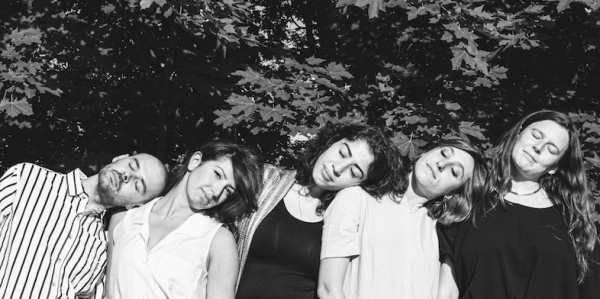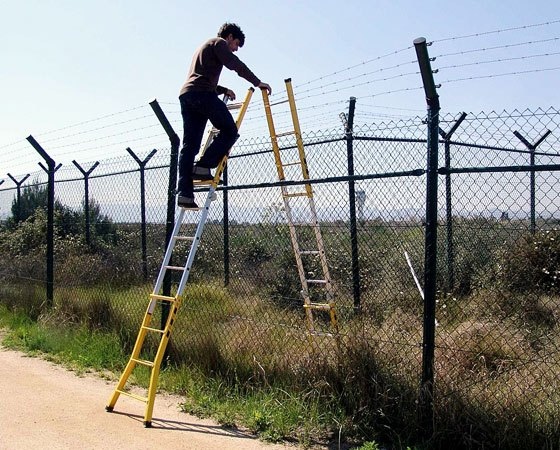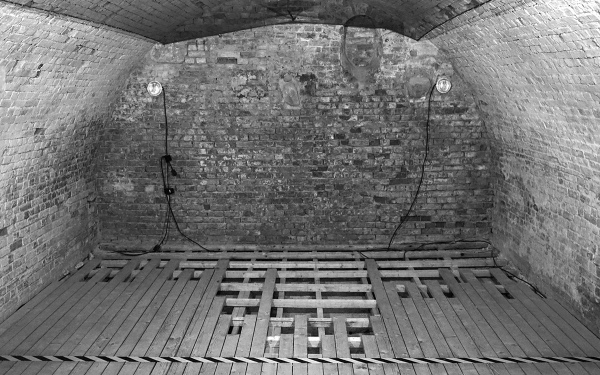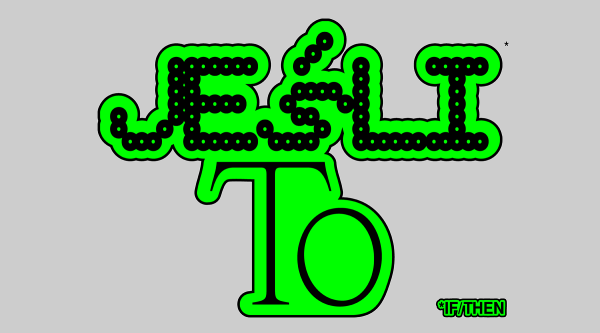talk
Entering the city through the kitchen door
Pau Faus, an artist and architect from Barcelona, is interviewed by Kaja Pawełek.
- How have you developed your interest in entering the city through the “kitchen door”?
- Now I think, however, that the city’s backstage is not a kitchen, rather, it is as if you took a look behind the scenes and saw something rawer, more real. Like in a theatre, where everything is structured and controlled, but when you peek behind the scenes you can see electrical cables in disarray, the other side of the decoration. My interest stems from curiosity, and it started with everyday 45-minute commutes by train to work outside Barcelona, during which I observed the landscape and found it intriguing. I pondered how it would feel to cross that space. I had the impression that by doing so I would acquire new information, that the experience of travelling in this area would be better informed by walking across it. Perhaps, I did not want this everyday landscape to remain so anonymous - I saw it every day for three years. It felt a little like sitting on the train next to the same person every day, until one day you finally ask their name.
- Was it caused by that theatrical impression, like when you peek behind the scenes to see how things are done?
- Yes, but certainly not everyone feels the same way about it, there are many different city outskirts in the world. I am from Barcelona and I studied architecture, I lived in Barcelona at a very special time, during the Olympic Games. In 1992, I was 18 years old at the time, the city was changing, going from success to success, everyone was talking about it, books were published about it, the city was the subject of university discussions all over the world. It was very good, on the one hand, but at the same time I realised that it was but a great set, a front of the city that was making every endeavour to keep it neat and nice, beautiful and touristy. And when all of a sudden in the midst of all this you see the situation in the city’s backstreets, you finally breathe a sigh of relief and think: thanks! At last something real! Urban scenarios have become so artificial that we feel relief in backstreet landscapes. I really need the experience of watching things that are unfinished, which have not been built to the requirements of strict legal regulations, nor designed by a celebrated architect, with a minimum of detail. If I lived in a place where everyone is dirty and everything is backstage, for a change I would seek something to the contrary, so I am not saying that one of these options is better and the other is worse - but it is about some balance.
- About an escape from hegemony and control, too?
- Rather, about things that are incomplete. Unfinished things give a picture of exclusion - often sad, spooky, very pessimistic. When you look at these parts of cities, they make you think that there are hidden issues that are hard to solve. But unfinished spaces at least allow you to imagine what they might become, what has happened there, what is the story behind them, what has not happened there. When you go to a perfect white space you just feel that you can sit down, there is no interaction. It is the backstage that induces dialogue. When you travel to South America, the unfinished, or rather everchanging cityscape of houses built one on another, which looks different in the morning, different in the evening, and still different on Sundays, may induce a more active vision. You are not just a passive lazy viewer expecting everything to be perfect.
- You have also said that certain routes we go require that we pay more attention to the experience of being here and now. Then you do not think about anything else, everyday issues, your head does not do all the mental trips outside the given place, nor do you meditate – you only focus strongly on that very moment in time. During our tour of Krakow there were moments when I felt clearly that we need to refocus, find a way, make decisions, choose the paths or even delimit them anew. Those were the moments when you feel very much inside the experience.
- Our walk in Krakow was good, but also maybe a little too easy ... To have a map is not always a good idea, no, but at places it was actually very needed. We tour the city aware that we know the way, we know where we are going, hardly any unpredictable situations, we know virtually everything. Going beyond the daily routine, the way to work, etc., gives you the opportunity to see the city like you never ever do. Of course, you can go one hundred kilometres away from Krakow for a weekend trip, but you might just as well go into an unknown part of the city - unknown to you, because, obviously, some people must live there. It is not about taking a trip, a break, or about moving around the place where you are able to foresee everything. It is about the experience of a true traveller, someone who steps out of their everyday situation.
- Do you consider your walking strategy to be more of a knowledge or experience building tool?
- Both dimensions are important. It seems to me that we are too much used to acquiring knowledge unsupported by direct experience. Teachers tell us that this is so and so, and we take it for granted. We know about a lot of things simply because we have been told about them. In many cases, this creates a reality that is very susceptible to manipulation, the way the story is told, etc., so for me to experience the city is to create my personalised map of it. One classic example is a district in Barcelona, traditionally considered to be dangerous. If you ask people whether this part of the city is dangerous, 99 percent will say it is very dangerous! And when you ask them, if they have ever been there, 99 percent will say: No, never. - Well, then how do you know it is dangerous? - Everybody knows.
- This is food for all urban legends...
- Yes. So I say, let's go to that dangerous neighbourhood and we'll see. If it is dangerous, I will confirm, yes, it is true, it is dangerous there. Of course, I am not able to generalise, my experience will only cover three hours spent in that place one day. In the end I will only be able to say that on that day and at that time I was there, it was so that when we took out the cameras, some people came up and told us to beware, others asked us to take a picture of them, at some places we felt that we were out of place among the disintegrating houses, at other places we were invited to come inside, someone played the guitar, sang and danced for us. Now, when I pass by such places on the train or motorway - because they are this kind of places - I only think about this experience. This is a very subjective knowledge, unsuitable for the city guidebook - because it has only happened to me, someone else will have had a completely different experience, but this is my own knowledge. I like to know the city through my own experiences. The idea is to acquire knowledge through experience, rather than to remember or repeat what someone else has already said.
- This also applies to architecture and the city when cognised through action – in view of the unpredictability of the urban scenario which can hardly be matched even by art. You never know what will happen, and it will be a one-off each time, something that cannot be exactly reproduced. For instance, because you yourself will not be the same – you will not be in the same mood, the weather will be different – already even on the level of the most general and banal circumstances everything is variable, and their constellations are nothing but other variants, slightly different each time. It is then about the performance that you and other people do, about this shared theatre - even though this is reality – collectively and individually created space.
- We know that even if we try to organise and control certain elements, the city is totally wild by nature. Unless martial law is enacted - which is a very good example of how you can control the city - that is by depeopling the streets. But even then, with today's technology we are able to communicate, organise and prepare ourselves - hence it is obvious that Internet access would have to be closed. This kind of state, however, cannot last long, anyway. Anyone with authority over the city needs to realise that this is a wild animal that cannot be domesticated. To put it very radically - you never know who might have a bomb in their pocket, so we just have to lump it. It is important to understand that the place belongs to us - and that we can use it as we please. We need not only to be law abiding citizens, the city is ours, it belongs to us as much as to others. Of course, sometimes we have to be clever enough to go unseen, but everyone knows their different ways to do so. And coming back to performance – at times it suffices to slightly change the perspective to cause everything to become performative. If all of a sudden you start walking backwards, or stand motionless in the middle of a rushing crowd on the underground – everything will change. This, of course, can be escalated - for example, by dancing in the middle of the street, but it is really about stepping, no matter how slightly, beyond the established limits.
- When we surreptitiously walked into the city in Krakow, suddenly the housing blocks appeared to be as exotic as the wilderness, the storks and pheasants we had seen on the way before. We did not get there suddenly, as would have been the case if we had arrived there in a car from the city centre, we came from somewhere, from the outside, and it took us some time. And suddenly it all gained a different dimension, even for someone who knows the local context.
- Yes, it is a linear experience.
- Do you remember those people who were totally surprised to see us taking pictures of garages and asked each other why we were doing it? Their behaviour betrayed some kind of anxiety and fear, a kind of belief that we were photographing the wrong places. I found it striking and characteristic of Krakow as a city that is increasingly identified by certain images specially prefabricated for tourists. The residents seem to have acknowledged them as “the Krakow” - that which must be promoted and photographed. The division into the front and backstage seems exceptionally powerful here. Concurrently, I had exactly the same feeling you have mentioned – it is so good that there are also such other places here where people live normal lives.
- When it comes to city icons - which is true of many tourist destinations in the world - great efforts are taken to simplify the city and turn it into an easily digestible product. Hence, the ideas like “Krakow in three days”, or, why not, “Krakow in 12 hours”. Someone selects a beautiful and well-kept location, prepares the experience - and the rest becomes the backstage that does not go well with the master scenario. Also, it is a fact that ordinary people, who live outside the master scenario, begin to accommodate and identify themselves with it, e.g. they ask: are you coming to Krakow? No, I will not show you where have my breakfasts, or where my children go to school. You have to see the market and St Mary’s church! Places I may never go myself, but feel compelled to show them to tourists. Sometimes such a look from the outside may even be considered invasive - why are you taking pictures of me, what is wrong about me? But there are also very friendly moments when citizens are keen to talk, to someone with genuine interest, about the place they live in and know well.
- On the other hand, you can also look at it as a distinction between the official and unofficial city. People wish to live normal lives and delegate all the touristy thing to the historic centre, pass on it the representative role so as to give all this theme park to visitors, and keep for themselves certain other advantages: lower prices, lower rents, the convenience of ordinary life.
- There are many threads here - these places are also part of the shared history, they are important for many reasons: monuments, architecture, etc. When Krakow is launching an ecobus, the idea must have been originated by someone in the marketing department.
- Like ghetto tours...
- Or communist tours. I think, again, that the target is to simplify the city, so that it is easy to consume, or easy to present on two pages in a budget airlines’ folder titled “Krakow, the greatest city”, etc. ... All these cities are vying for their uniqueness, but eventually they become copies of one another, because they turn into hollow amusement parks. Again, this kind of representation is internalised, just like the general knowledge of “do not go there, it is dangerous there”. Especially tourists hear many such warnings. People develop their own perception of the city through someone else’s interpretation. This is sad, it seems to me that the idea is to have your own subjective interpretation. I am in the given place one day, I am happy to talk to people and they talk to me. On another day, I do not want to talk to anyone, no one speaks to me and this place seems terrible to me - only because on that day I feel this way, and not otherwise. Or simply because it is raining. We need to argue against total or generalising statements, and the way to do this is to say: my experience was such and such. Old community centres in cities are increasingly becoming tourist icons, and local residents do not meet there anymore. However, new centres are appearing – a shopping centre is built near a new settlement and it becomes a new community centre. We have a lot of negative associations with these places, but many of them have become very strong centres of social life, naturally linked to consumption, but in many cities parking lots and petrol stations are young people’s meeting places, where no one will bother them. And just as once upon a time it was the town square, so now it is a petrol station, round-the-clock shop, or an empty parking lot - such maps are possible, too.
- In Australia (and probably in Poland) in small towns people meet in supermarket aisles and there they gossip or discuss issues, because the traditional agora, an open meeting place is no more.
- Of course. Or, as in the case of that metal something that we saw in Krakow...
- ???
- Where you clean ... That metal structure ... You said that it was a meeting point ...
- Carpet beating frame!
- Such places lend themselves to meetings, just like telephone booths did in the past. People used to go to call the family and they met there. In Spain, we now have a lot of call centres, where immigrants can call cheaper - and of course they have become meeting places for these communities.
- What was your experience from projects of hiking around Barcelona? You have said how difficult it was to document and later show them to people who did not participate in them.
- Problems with documentation are common to all such projects. During the last project we walked around the city for eight days, which significantly extended the experience. We did not, however, sleep in the open air, but went back home. The project was part of an exhibition, so later we had to somehow explain the whole idea and action. I think this is a very personal experience - the participants may have very different motivations. When we are experiencing an experience we try not to think about how to explain it later, what photographs we are taking, we try to be as relaxed as possible and enjoy the experience. In this case, we decided to publish a book. Then, when we were looking through the documentation comprising three thousand pictures, we had to choose three hundred and we decided to focus on the presence of people in the landscape - and instead of showing a picture of a beautiful tree, we would rather show a chair standing next to it – a kind of human traces, footprints on the ground. However, when you look at all the documentation some time later, you realise that it is but a fraction of the experience, and that the most important thing was to go that route. This applies to the simplifications we employ - we are used to being able to tell about a place with two or three pictures and a short text, e.g. what Krakow is like. Like in a guidebook which contains all you need: pictures, maps, and texts. For subjective experience, you just have to accept that you cannot explain it - because that would simplify the experience. So you choose two or three pictures to help others understand what happened, but the essence of it all, something that will never be on display in an institution of art, is the experience. When you travel for six months in South America and someone asks you: “How was it? Tell me about it. I want to know everything.” - it is very difficult, for what can you say? Sometimes it was funny, sometimes sad. Sometimes it was interesting, sometimes boring, sometimes I did not want to do anything, and sometimes I was sociable - only you know what it looked like. When someone organises a tour and explains that this building was built then and then, it was here that this and that happened, etc., then that dimension is lost.
- Could you tell me about the action when you walked for five days to get to Barcelona?
- We walked into the city simultaneously from five different directions, a bit like in a military action. As in Krakow, we had to overcome various obstacles characteristic of the peripheries of the city. Entering the centre from the outside, after having negotiated the obstacles, you find yourself in the proper city, with its streets, where you wait for the green light, etc.. What was interesting in this project was that we acted simultaneously as a group - at the end we had a set meeting point.
- Is this collective aspect particularly meaningful to you?
- For a long time we operated as a team under the name Osservatorio Nomade Stalker. Now we are more scattered, but it is always interesting to work together, because you can see how divergent our interests and motivations are. Some are strongly interested in going to places where there is a local problem that needs to be attended, some remember that the given place used to look different and want to see the change, while others are simply attracted by the prospect of taking a different view of the city. Walking around the city sometimes is just an adventure. What we do, however, can also be seen as an attempt to show the variety of practices and methods of looking at the city, reveal the ways of other people, who sometimes enjoy the freedom of living on the borderline of the city / out of the city, and sometimes suffer for living out of the centre. Living in the backstage entails much injustice - because no one cares. In many cases, peering behind the scenes of the city translates into the will to lend a hand, but just as well it can be nothing more than a specific experience gaining strategy. My recent projects employed the latter approach, as was the case with Krakow. Sometimes, of course, it was so that I wanted to explore a place, stay longer there, work with the local people. These are two different approaches, perhaps partly contradictory, but they can co-exist, too.
- To what extent were the strategies employed by the Situationists important to you?
- The cityscape changes us into zombies in view of the sheer volume of information and communications that inundate us in the city, the number of people who want to attract attention, e.g. with their appearance. At some point you have to just close your eyes and go, because we have our own errands and things to do. On the other hand, alienation is very susceptible to commercial and political manipulation. The Situationists were critical from the political perspective - and wanted to challenge the imposed ways of exploiting the city and propose alternative strategies. Previously, as was the case with Baudelaire and the flâneur figure, it was more about the fascination with the upcoming modern city viewed from the perspective of an outsider, who took a step back. The Situationists, instead, stepped forward, as you go against the wind.
- You have mentioned a very interesting thing about the landscape of informal cities or districts, favelas, shantytowns - that the image they create is a vital sign, a continuous transformation, non-termination due to an unfinished living process which goes on there interminably. Could you say something more about selfconstruction as a strategy?
- We used to consider urban planning as a consolidation practice – someone comes in and decides: we will have a park here, a block of flats there, this will be a square for everyone to meet there – and, of course, sometimes it is necessary. This is what interests me in the development of new buildings, it is not the building itself, which should be just good, but rather what happens next – post-architectural situations. When a building is finished, people move in and begin to get used to that new place, they begin to change it. In the Western world this is difficult, because there are many regulations concerning even the type of windows, the layout of the walls, etc., you have to achieve a permission to do anything – but people still do it, even by placing flowers on balconies. The building gets used to the people, and the people get used to the building. Relations develop between the people inside the building, neighbours. I am interested in how people exploit architecture. If there exists no ready-made structure when people are moving in, i.e. when they are living and building at the same time, their houses accommodate the course of their lives. When they have children, a new floor is built, when a friend moves in, another floor is built, when they have earned enough money, they paint the facade, etc. There is a very clear relationship between the resident and the house which becomes a living object. This shows how autonomous people can be, and how changes can be manifested. We know that behind those monotonous facades that look the same – like, for instance, in Warsaw – there exist diverse lives. Behind those 25 windows that look the same there are 25 different life stories, and if a building is a hundred years old, it is a home to many subsequent generations. With the practice of self-construction you can see this more clearly, as it is fairer. Of course, when it comes to favelas in South America, you have to be very careful, because their existence is most often associated with difficult situations in life, but at the same time people are very proud of having built a house with their own hands, perhaps they have even laid the pavement in the street together with their neighbours. So there is a relationship with the place, which, for example, I do not have – all I have done in my own home was painting the walls and hanging something on them. It is different when you can point at any component of the house and say: this window comes from here or there, I bought the door, I laid the floor with my brother, my father did this, we built this piece all together from the stones we had brought from the hill, etc. I do not want to go into excessively poetic descriptions, but this affects the very practical side – they simply have a very strong relationship with the structure of the house. These buildings are permanently unfinished, on the one hand due to financial reasons, on the other - because everything is changing and it is no point completing them when in a moment the situation will require a different living space. The ever present smell of fresh paint is characteristic – because everything changes, the landscape changes, too, in ten or twenty years it will look completely different. In traditional cities such changes are hidden behind the facades, but they do take place there, the course of life changes, these changes are included in the cityscape. It seems important to me that cities should be planned not from the level of bird’s eye view, but from the ground, the street, as we see it while walking the streets. And it is not just that there is a park here, a housing estate there, etc. – it is much more, just as a lot more is hidden behind the supposedly identical windows of the building. Self-construction, which we have applied in several projects, is also important not only as hand-building, but as a process, as well, during which you make decisions about what you want to build – which is the converse of the way we work as architects. I really liked the phrase I had heard from someone in Chile: the house has not been designed, the house has become. You can not predict the life that will be lived there, but you can respond to what happens.




